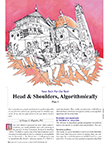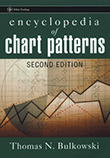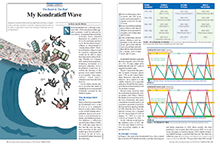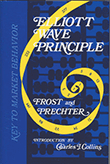LETTERS TO THE EDITOR
June 2013 Letters To The Editor
The editors of S&C invite readers to submit their opinions
and information on subjects relating to technical analysis and this magazine.
This column is our means of communication with our readers. Is there something
you would like to know more (or less) about? Tell us about it. Without a source
of new ideas and subjects coming from our readers, this magazine would not
exist.
Address your correspondence to: Editor, Stocks & Commodities,
4757 California Ave. SW, Seattle, WA 98116-4499, or E-mail to editor@traders.com.
All letters become the property of Technical Analysis, Inc. Letter-writers
must include their full name and address for verification. Letters may
be edited for length or clarity. The opinions expressed in this column do not
necessarily represent those of the magazine. —Editor
HEAD & SHOULDERS REVISITED
 Editor,
Editor,
In the May 2013 Letters To S&C, reader George Jones brings up some identification issues regarding Giorgos Siligardos’ April 2013 article (“Head & Shoulders, Algorithmically, Part 1”). The question that was considered was: Can we call a pattern a head & shoulders if the neckline slopes differently or the volume trends differently than is described in historical texts (such as the one mentioned in the letter, Technical Analysis Of Stock Trends by Robert Edwards & John Magee)?
Jones makes an interesting point that it is important to consider the work of others. Siligardos, in his reply, is also correct regarding neckline slope and volume trend as they relate to trading, but they can also be important to identification.
Knowing that today’s markets are different from those when Edwards & Magee lived, I researched the performance of the head & shoulders pattern and tested the neckline slope, volume trend, and other attributes, and published the results in my 2005 book, Encyclopedia Of Chart Patterns, Second Edition. I used the historical record to build a foundation, and then let the test results describe which variation worked best.
For the head & shoulders top, I found 814 patterns in bull and bear markets. Patterns with downsloping necklines resulted in the worst performance (horizontal and upsloping were better, respectively). Patterns with a rising volume trend also outperformed those with a falling trend. The same results occurred in both bull and bear markets.
A glance at the Edwards & Magee book shows numerous charts of head & shoulders tops with upsloping necklines, and they describe the volume pattern as being sometimes highest on the left shoulder, sometimes equal to the head, and sometimes the head has a higher volume.
My conclusion is this: If it looks like a duck and quacks like a duck — even if it has a weird neckline or leaves behind a volume of droppings — it’s still a duck.
Tom Bulkowski
 Thomas Bulkowski has contributed numerous articles to Stocks & Commodities over the years on topics ranging from candlesticks to chart patterns of all kinds. We also interviewed him for our September 2006 issue. Readers will find these articles here at our website.
Thomas Bulkowski has contributed numerous articles to Stocks & Commodities over the years on topics ranging from candlesticks to chart patterns of all kinds. We also interviewed him for our September 2006 issue. Readers will find these articles here at our website.
In addition to the Encyclopedia Of Chart Patterns, Bulkowski is also the author of Encyclopedia Of Candlestick Charts, a recent book trilogy (Trading Basics: Evolution Of A Trader, Fundamental Analysis And Position Trading: Evolution Of A Trader, and Swing And Day Trading: Evolution Of A Trader), and other books. —Editor
KONDRATIEFF WAVES
 Editor,
Editor,
I read with great interest Koos van der Merwe’s articles in S&C about K-waves (“Reelections And The Presidential Cycle,” April 2013; “The Kondratieff Wave And The Presidential Cycle,” July 2012; “Today’s K-Wave And Beyond,” April 2011). I’ve also read A.J. Frost & Robert Prechter’s book about Elliott wave theory (Elliott Wave Principle).
One of my questions for Merwe is: In his opinion, is Elliott wave theory always valid today? In his articles, Merwe explains that computerized trading seems to be responsible for some lag between K-wave theory (economic cycles) and market cycles. Is the same true for Elliott wave theory? In Frost & Prechter’s book, I couldn't find an answer to this question. I live in France and I follow the CAC 40 index even if I’m thinking of investing in, say, the Japan Lyxor ETF. Can I overlay K-waves on the CAC 40 and make an analysis similar to Merwe’s? Is the same true for the Nikkei 225?
Nicolas
France
Author Koos van der Merwe replies:
I have been an Elliottician since 1969 when I discovered Elliott wave theory. In the years I have analyzed charts using Elliott wave, I have discovered variations not mentioned in Frost & Prechter’s book. For example, in the late 1980s I wrote to Prechter, asking him whether a Wave 3 can be less than a Wave 1. He replied to me that when that occurs, Wave 5 will then be less than Wave 3. Since then, I have come across a few other variations. For example, I have often found an “ab” correction halfway in a Wave 3. I have also found that Wave 1 has become more complicated. The more complicated the wave, the smaller the Wave 2 correction. These are all variations that have occurred most likely because computer trading takes away emotion from trading, which did influence the market greatly.
 Frost & Prechter wrote their book, Elliott Wave Principle, prior to 1978. The first edition was published in 1978 by New Classics Library. This was before computers landed on everyone’s desks. Would Prechter change anything in the book should he ever decide to rewrite it? I don’t think so. But I do believe that things have changed. One thing I always keep in mind is the first rule of Elliott wave theory — that is, “The chart must look right” (that is, correct). This is a rule many Elliotticians tend to forget. And yes, you can apply Elliott wave analysis to any and every chart you look at, even to the Japanese indexes.
Frost & Prechter wrote their book, Elliott Wave Principle, prior to 1978. The first edition was published in 1978 by New Classics Library. This was before computers landed on everyone’s desks. Would Prechter change anything in the book should he ever decide to rewrite it? I don’t think so. But I do believe that things have changed. One thing I always keep in mind is the first rule of Elliott wave theory — that is, “The chart must look right” (that is, correct). This is a rule many Elliotticians tend to forget. And yes, you can apply Elliott wave analysis to any and every chart you look at, even to the Japanese indexes.
I must add that I often look at the relative strength index (RSI) to help me finalize a correction. So yes, Elliott wave is difficult to analyze, but never forget: It is simply a signpost, and that signpost can change very quickly a little way down the road.
I hope I have answered your question satisfactorily.
S&C VOLUME NUMBERING
Editor,
Can you tell me the dates of the following issues that I came across in your article archives at your website: v18:15 and v19:14? Also, are pictures of your individual issue covers available anywhere in the archive?
Daniel
Volume 18 (v18) refers to the year 2000 and volume 19 (v19) corresponds to the year 2001. In this case, chapters 14 & 15 referred to the product review and book sections of our annual printed volumes compiling the year’s issues.
As for pictures of our individual issue covers, you will find them in our complete cover archive:
https://technical.traders.com/archive/CoverArchive.asp
—Editor
Originally published in the June 2013 issue of Technical Analysis of Stocks & Commodities magazine. All rights reserved. © Copyright 2013, Technical Analysis, Inc.
Return to
Contents
 Editor,
Editor, Thomas Bulkowski has contributed numerous articles to Stocks & Commodities over the years on topics ranging from candlesticks to chart patterns of all kinds. We also interviewed him for our
Thomas Bulkowski has contributed numerous articles to Stocks & Commodities over the years on topics ranging from candlesticks to chart patterns of all kinds. We also interviewed him for our  Editor,
Editor, Frost & Prechter wrote their book, Elliott Wave Principle, prior to 1978. The first edition was published in 1978 by New Classics Library. This was before computers landed on everyone’s desks. Would Prechter change anything in the book should he ever decide to rewrite it? I don’t think so. But I do believe that things have changed. One thing I always keep in mind is the first rule of Elliott wave theory — that is, “The chart must look right” (that is, correct). This is a rule many Elliotticians tend to forget. And yes, you can apply Elliott wave analysis to any and every chart you look at, even to the Japanese indexes.
Frost & Prechter wrote their book, Elliott Wave Principle, prior to 1978. The first edition was published in 1978 by New Classics Library. This was before computers landed on everyone’s desks. Would Prechter change anything in the book should he ever decide to rewrite it? I don’t think so. But I do believe that things have changed. One thing I always keep in mind is the first rule of Elliott wave theory — that is, “The chart must look right” (that is, correct). This is a rule many Elliotticians tend to forget. And yes, you can apply Elliott wave analysis to any and every chart you look at, even to the Japanese indexes.